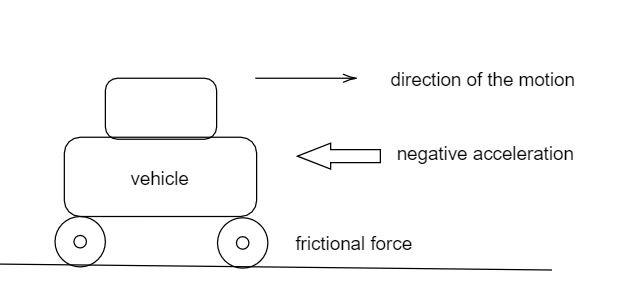
An automobile vehicle has a mass of $1500\,Kg$. What must be the force between the vehicle and road if the vehicle is to be stopped with a negative acceleration of $1.7\,m{s^{ - 2}}$ ?.
Answer
568.2k+ views
Hint
Use the formula given below and substitute the values of the mass and the acceleration of the vehicle in that formula. The answer obtained shows the force acting between the vehicle and the road that must help the vehicle to stop its movement.
The Newton’s second law of motion is
$\Rightarrow F = ma$
Where $F$ is the force acting on the object, $m$ is the mass of the object and the $a$ is the acceleration acting on the object.
Complete step by step answer
The given data from the question is
The mass of the vehicle, $m = 1500\,Kg$
The acceleration acts on the vehicle, $a = - 1.7\,m{s^{ - 2}}$ (since the acceleration makes the vehicle to stop)
The acceleration of the vehicle makes it stop by the application of the frictional force. Hence the frictional force between the road and the vehicle is calculated by using Newton's second law.

By using the formula,
$\Rightarrow F = ma$
Substituting the value of the mass and the acceleration of the vehicle in the above formula,
$\Rightarrow F = 1500 \times - 1.7$
By performing multiplication,
$\Rightarrow F = - 2550\,Kgm{s^{ - 2}}$
We know that $1\,N = 1\,Kgm{s^{ - 2}}$
$\Rightarrow F = - 2550\,N$
Thus the frictional force between the road and the vehicle is $2550\,N$(negative since this stops the movement of the vehicle).
Note
The negative acceleration implies that this acceleration is required by the vehicle to stop its movement. Here the acceleration changes negative and opposite as the velocity. This acceleration that retards the movement said as the deceleration.
Use the formula given below and substitute the values of the mass and the acceleration of the vehicle in that formula. The answer obtained shows the force acting between the vehicle and the road that must help the vehicle to stop its movement.
The Newton’s second law of motion is
$\Rightarrow F = ma$
Where $F$ is the force acting on the object, $m$ is the mass of the object and the $a$ is the acceleration acting on the object.
Complete step by step answer
The given data from the question is
The mass of the vehicle, $m = 1500\,Kg$
The acceleration acts on the vehicle, $a = - 1.7\,m{s^{ - 2}}$ (since the acceleration makes the vehicle to stop)
The acceleration of the vehicle makes it stop by the application of the frictional force. Hence the frictional force between the road and the vehicle is calculated by using Newton's second law.

By using the formula,
$\Rightarrow F = ma$
Substituting the value of the mass and the acceleration of the vehicle in the above formula,
$\Rightarrow F = 1500 \times - 1.7$
By performing multiplication,
$\Rightarrow F = - 2550\,Kgm{s^{ - 2}}$
We know that $1\,N = 1\,Kgm{s^{ - 2}}$
$\Rightarrow F = - 2550\,N$
Thus the frictional force between the road and the vehicle is $2550\,N$(negative since this stops the movement of the vehicle).
Note
The negative acceleration implies that this acceleration is required by the vehicle to stop its movement. Here the acceleration changes negative and opposite as the velocity. This acceleration that retards the movement said as the deceleration.
Recently Updated Pages
Master Class 11 Economics: Engaging Questions & Answers for Success

Master Class 11 English: Engaging Questions & Answers for Success

Master Class 11 Social Science: Engaging Questions & Answers for Success

Master Class 11 Biology: Engaging Questions & Answers for Success

Class 11 Question and Answer - Your Ultimate Solutions Guide

Master Class 11 Business Studies: Engaging Questions & Answers for Success

Trending doubts
10 examples of friction in our daily life

One Metric ton is equal to kg A 10000 B 1000 C 100 class 11 physics CBSE

Difference Between Prokaryotic Cells and Eukaryotic Cells

1 Quintal is equal to a 110 kg b 10 kg c 100kg d 1000 class 11 physics CBSE

State the laws of reflection of light

Explain zero factorial class 11 maths CBSE




